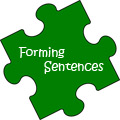 Last week I wrote a blog post entitled: “Teaching Metalinguistic Vocabulary for Reading Success” in which I described the importance of explicitly teaching students basic metalinguistic vocabulary terms as elementary building blocks needed for reading success (HERE). This week I wanted to write a brief blog post regarding terminology related to one particular, often ignored aspect of writing, punctuation.
Last week I wrote a blog post entitled: “Teaching Metalinguistic Vocabulary for Reading Success” in which I described the importance of explicitly teaching students basic metalinguistic vocabulary terms as elementary building blocks needed for reading success (HERE). This week I wanted to write a brief blog post regarding terminology related to one particular, often ignored aspect of writing, punctuation.
 Punctuation brings written words to life. As we have seen from countless of grammar memes, an error in punctuation results in conveying a completely different meaning.
Punctuation brings written words to life. As we have seen from countless of grammar memes, an error in punctuation results in conveying a completely different meaning.
In my experience administering the Test of Written Language – 4 (TOWL – 4) as well as analyzing informal writing samples I frequently see an almost complete absence of any and all punctuation marks in the presented writing samples. These are not the samples of 2nd, 3rd, or even 4th graders that I am referring to. Sadly, I’m referring to written samples of students in middle school and even high school, which frequently lack basic punctuation and capitalization.
 This explicit instruction of punctuation terminology does significantly improve my students understanding of sentence formation. Even my students with mild to moderate intellectual disabilities significantly benefit from understanding how to use periods, commas and question marks in sentences.
This explicit instruction of punctuation terminology does significantly improve my students understanding of sentence formation. Even my students with mild to moderate intellectual disabilities significantly benefit from understanding how to use periods, commas and question marks in sentences.
I even created a basic handout to facilitate my students comprehension of usage of punctuation marks (FREE HERE) in sentences.
Similarly to my metalinguistic vocabulary handout, I ask my older elementary aged students with average IQ, to look up online and write down rules of usage for each of the provided terms (e.g., colon, hyphen, etc,.), under therapist supervision.
 This in turns becomes a critical thinking and an executive functions activity. Students need sift through quite a bit of information to find a website which provides the clearest answers regarding the usage of specific punctuation marks. Here, it’s important for students to locate kid friendly websites which will provide them with simple but accurate descriptions of punctuation marks usage. One example of such website is Enchanted Learning , which also provides free worksheets related to practicing punctuation usage.
This in turns becomes a critical thinking and an executive functions activity. Students need sift through quite a bit of information to find a website which provides the clearest answers regarding the usage of specific punctuation marks. Here, it’s important for students to locate kid friendly websites which will provide them with simple but accurate descriptions of punctuation marks usage. One example of such website is Enchanted Learning , which also provides free worksheets related to practicing punctuation usage.
In contrast to the above, I use structured worksheets and punctuation related workbooks for younger elementary age students (e.g., 1st – 5th grades) as well as older students with intellectual impairments (click on each grade number above to see the workbooks).
I find that even after several sessions of explicitly teaching punctuation usage to my students, their written sentences significantly improve in clarity and cohesion.
One of the best parts about this seemingly simple activity, is that due to the sheer volume of provided punctuation mark vocabulary (20 items in total), a creative clinician/parent can stretch this activity into multiple therapy sessions. This is because careful rule identification for each punctuation mark will in turn involve a number of related vocabulary definition tasks. Furthermore, correct usage of each punctuation mark in a sentence for internalization purposes (rather mere memorization) will also take-up a significant period of time.
How about you? Do you explicitly work on teaching punctuation?